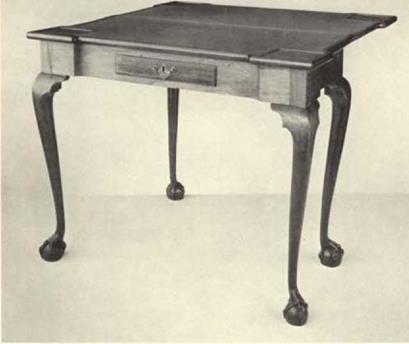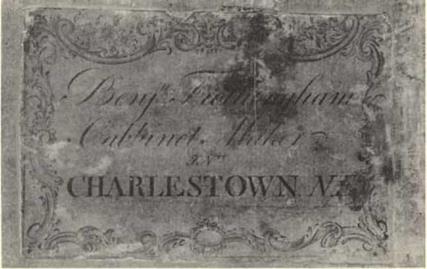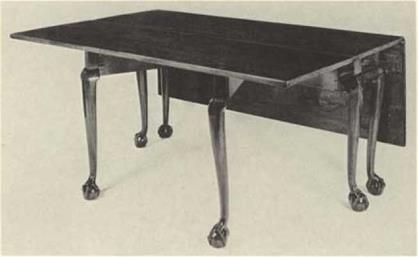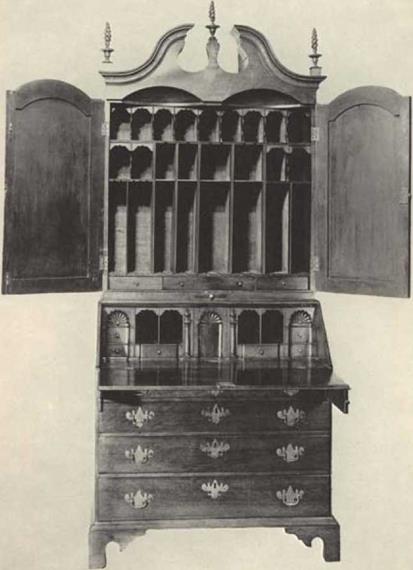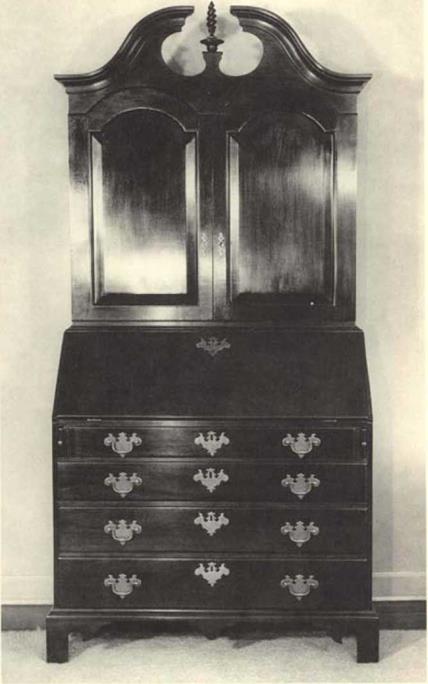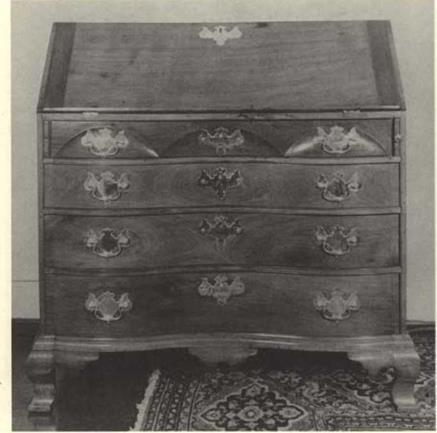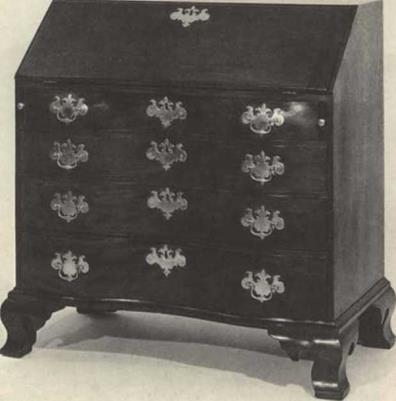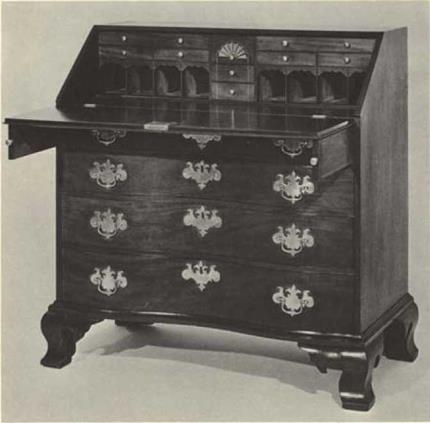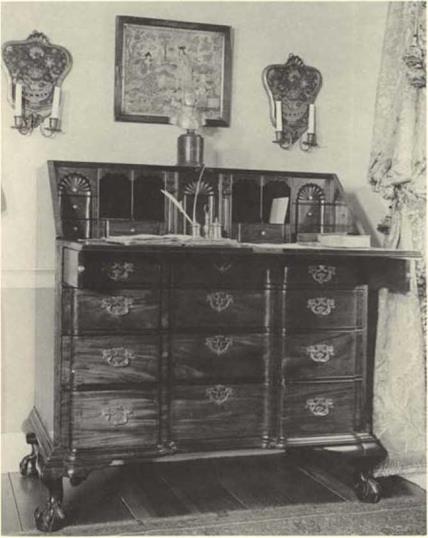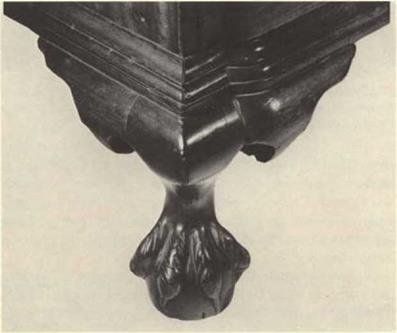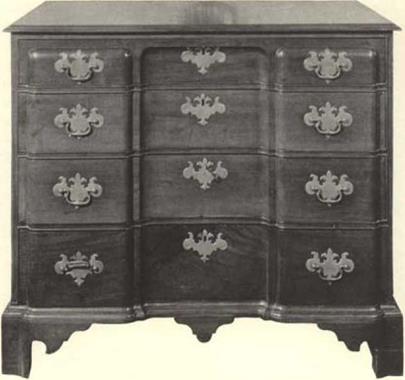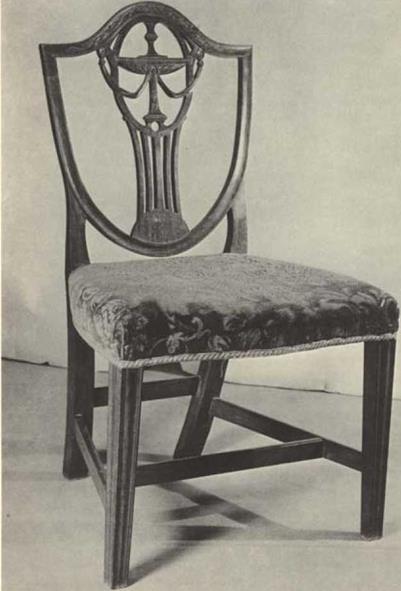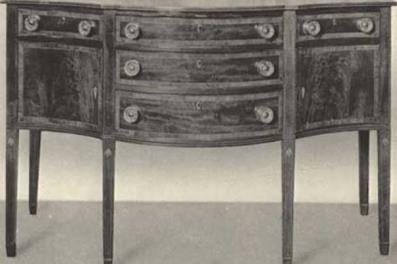|
S |
O few Artier ran cabinetmakers have Ictr behind a broad variety of signed work that the picture of normal daily production cannot be easily examined by the student. William Savery of Philadelphia, John Townsend of Newport, and Benjamin FrOthing – hani of Charlestown arc three major exceptions in the eighteenth century, each having liberally labelled his furniture, while others as competent did not seem to do so. Among the many famous cabinetmakers of Boston, like John Cogswell, George Bright, and Ebenezer Hartshonie, sometimes only one or two pieces have retained signatures or maker’s marks, while in the case of Alexander Edwards, who paid as high a tax as Bright, not a single example is known. The signed furniture of Benjamin Frothingham is, therefore, worth considering as giving the broadest view’ of a typical workshop of the Boston region in the eighteenth century.
Benjamin Frothingham (April 6. 17J4- August 19, 1809] was the son of the joiner Benjamin Frothingham (1708-1765) of Boston, The lather had a shop in Milk Street, recorded to have burned in the great fire of Marcli zo. 1760, and presumably the younger Benjamin was trained in that shop, hi 1756, our Benjamin Frothingham bought a parcel of land in Charlestown where he seems to have been established from at least 1754 until his death in i8op.] At the time of the Revolution, his shop in Walker Street was one of twenty-nine cabinetmakers * establishments which were destroyed when the town of Charlestown was burned by the British on June 17, 1775. He was a member of Captain Gridicy’s militia from 1754 and served in the
1. Mibd M, Swan. "Major Henjimtn FroLtiingham, Cabinetmaker,” Anti pits, lxu: (November, ipsa), зэг-ЭЛ*.
|
|
1>]. High CHEST. Made by Benjamin Frorhingliaits (signature in chalk), Charlestown. c. 1755-17*». Mahogany and white pine: н. 8у% inches, w, 42 inches, U. ізV» inches. (The Henry Francis du Pont Winterthur Museum.) This that and watching dressing table (Jig, jjj) may have btat owned by Nalheidel Richards (tyti-iySS), an innholder and Saddler of Roxbury. His name appears in chalk on the bottom of the long drawer in the lower seetitm.
Revolution becoming a major by war’s end – He retained the title of “Major” all bis life, and it has often been noted that George Washington visited Frothingham, “whom be had known in the army," in 1789 in Charlestown, The cabinetmaker was also a member of tile Society of the Cincinnati,2 His wife was Mary Deland by whom he had seven children, one of whom, Benjamin (bom 1774), followed the family trade.
The example of John Townsend’s labelled furniture gives fair warning to all who would date furniture purely 011 the basis of style, since his work includes pieces in the styles of the mid-century dated in the 1790s, His three-shell chest in the Metropolitan Museum (fig. 49) is dated 1765, for instance, and a second labelled three-shell chest, now in the State Department, is dated 1792.3 There are minor concessions to the new neoclassirism, in the choice of plain bail handles and a slight change of proportion and lightening of the moldings of the top, but the answer to dating furniture probably lies in the taste of the man who commissioned it, not in the taste of the cabinetmaker.
Hence, the furniture of Frothingham to be examined is placed in the order of stylistic sequence for simplicity, with no intention of implying dates, early or late. The first examples to consider arc in the pad-foot cabriole style of the mid-century.4 There is a dressing table and matching high chest of drawers, now in the Winterthur Museum and formerly in the Charles K, Davis Collection, with simple cabriole legs and “plain feet," as they were called (figs, 154 and 155). Each piece has a nicely executed fan in one drawer, the proportions
z. A summary of Frothmgham’s military exploits and the earliest notes im his life ire found ill DtKIH Edwin Spading, "Benjamin Ftutbinglmn of Cbarlntitwn, Cabinrt niak cr jnd Soldier," Antiques, XIV (December. igiS)r і Jfi-S J7- Frothingham’* ґcTltftCз [f t)f membership in tile Society of the Cincinnati, signed by timrge Washington and Henry Knox and dated May j, 17Й4, hat survived and is presently owned by Cinsbuig and Levy. Inc., New York,
]. CiemeilT E. C olljjct and Jane W. Fool. ”Americana in the Diplomatic Reception Rooms it the Depart mm і of State, Washington, D. C.,1′ The Comwiiseur, tuoav (July, 1974І, izo. He*’ 7. 3.
4.1 would like to acknowledge the great help of Albert Sack in acquiring photographs and information for this paper. His many years оГobserving details in furniture related to Frothinghaiu have been of signal help, as has the fir til’s photograph collection.
are good, and the high chest terminates in a well-shaped bonnet with three corkscrew finish. The pieces are made of an unusual bur] wood, formerly called curly walnut, but now identified as a type of plum pudding mahogany, flic wood is very beautiful and gives considerable interest to the surface, as do the pierced fret brasses on the drawers. Two of the brasses arc unusual in that they are stamped dearly on the lower edge of the face “I. Gold," presumably the name of the maker or supplier. Interior construction is of white pine throughout. One drawer in the high chest is signed in chalk: "Benjamin Frothingham" and "Nathanael Richards" (probably die name of the owner),5
In the cabriole style are two examples at Winterthur having claw feet with raked talons, typical of the Boston region. One is a card table with reverse blocked sides, nicely emphasizing the comers of the table and accommodating the candle pockets (fig. 156). The legs arc long anti lean widi a sophisticated curve and unusually delicate ankles. The piece is labelled in the drawer with one of the labels engraved for Frothingham by Nathaniel Hurd, the silversmith of Boston (fig. 157). Its secondary woods arc white pine and maple/ The second claw table at Winterthur is unusual in itself, since so few of the type survive (fig, 158). It is a six-legged claw foot dining table with two swinging gates to support each large leaf. It is built of light-hued mahogany with white pine and maple as its secondary’ woods, and is labelled beneath with Hurd’s paper label. The legs are well shaped, but not as delicate as those of tire card table, hOr arc the carved talons as acutely raked.7
Two secretaries with plain bracket feet number among Froth і tig – ham’s labelled works. One is made of cherry, an unusual wood in Boston-area practice, and wa$ formerly m the collection of Emcst
j. Helen Comstock, "Froihiu£tnm лік) the Question 0Г Attributions," AmitjHn, 1 ми (Jane, igjjJ, joi, fig. j showing зідпапігс; sec also Charles F. Huninid,“Queen Anne ліні Chip|wnJ*lc Funmure in the Hairy Francis du Pont Witiimhitr Museum, Part 111," Antiques, XOX (January, Ц)7′}, ОЙ-іСи,
<S, Joseph Downs, Апктісап Furniture Queen Anne лпd Chipptndth Ptriuis іл rfrr Henry Francis du Pont Winterthur Museum (New York, no, J*jl,
7. Swan, "Major Ucnjamin Frothiighain," p. 393,
|
155, Dkhssitsc Tabi-K. Attributed to Benjamin rrothingham, Charlestown, c. 1755- 173c, Malioginy and white ріне: ii – Jtl/a inclirs, w. jj% inches, d. 30% inches, (The Henry Francis du Pont Winterthur Museum.) 7liij table is a mate r6 the ehest illustrated in fig – J-H- |
Lo Nano (fig. 159). The base lias a straight front, and the bookcase top has doors with fielded panels terminating in flattened arches. Tile bonnet top resembles the Winterthur high chest with three corkscrew fmiais. Tiie interior of the bookcase is divided into eight compartments with two rows of eight ogee-headed pigeonholes above. The desk interior has three reverse blocked sections, containing drawers at each end and a central door, each carved with a fan at the
|
156- Cahd Tajile. Made by Benjamin Frothingham (paper label), Charlestown, c. 1755-1790. Mahogany, white pine, and maple 1 H. 2& inches. W, J4l/S inches, n. 16% inches (dosed), 33% indies (open). (The Henry Francis du Font Winterthur Museum.) See also fig – 1J7- |
top (fig. 160). These, like the fans of the Da vis-Winterthur examples, have л notched or as it is sometimes called a "thumbprint" profile. There are two round-headed pigeonholes between, with a blocked drawer below. The bracket feet have a simple single spur for decoration.*
The second secretary, belonging to William T. Earls in 195г. is rather similar (fig. 161). It is broader in proportion and made of mahogany, but the details of the bookcase interior, the desk, and die
8. Ibid.
|
157. Detail or Раі’ЕИ Laiskl oh Сани Table: "Ikiijn. Frothingham / Cabbinct Maker / IN / CHARLESTOWN, N£.” {The Henry Francis flu Pont Winterthur Museum.} Sec also fig. 156. |
feet arc nearly identical. It is furnished with only a single middle fmial, while the central opening of the bonnet is somewhat wider and rounder m proportion to the breadth of the secretary. There is also a shaped drop in the center of the skirt to accommodate the width of the piece. The mahogany is rather black, and the secondary wood is pine. It is marked with die Hurd paper label m an inside drawer.4
The third secretary ist like the Da vis-Win terthur high chest, signed on the drawers, this time in four places (figs, 97 and 162), It is an unusual mahogany bombe sec re tar)1 with molded bracket feet- The bookcase upper section again has fielded panels in the doors, with round, rather than flattened arches at the top, and the bonnet is shaped like those already illustrated with three corkscrew finials. The
0L [bid., p. sji.
|
158. Dininc Table. Made by Dcnjnmin Frorhinghani [paper label), Charlestown, t. ‘7SS_’7y*5, Mahogany, maple, and white pine; », ;Jt% inches, vi. $9 inches (open), D. 60% inrhfTi (Tile Henry Francis dn Pont Winterthur Museum.) |
upper case is divided by three fluted pilasters with capitals of the Corinthian order. They are richly carved with acanthus leaves against a punched ground. In the interior of the case are two intaglio fans at the top. three drawers at the bottom and a series of pigeonholes running up each side. In the center are three movable book shelves. The desk is contrived in an amphitheatre arrangement with two tiers of drawers below four pigeonholes ar each side. Tile central door is reverse blocked with a round-headed panel. There are two narrow document drawers with plain pilasters and acorn fiuials. The long lower drawers have normal straight sides, and the bom be form is carried out by the shaping of the exterior of the case. Red cedar is die major secondary wood.10
The signatures on die bomb^ secretary are interesting from several points of view. On the back of the top large drawer is the following
10. TIil* information and photographs were kindly supplied by Clement Conger, Chairman of the Fine Arts Committee, fhc Рсрлптегн of State, Washington, D. C.
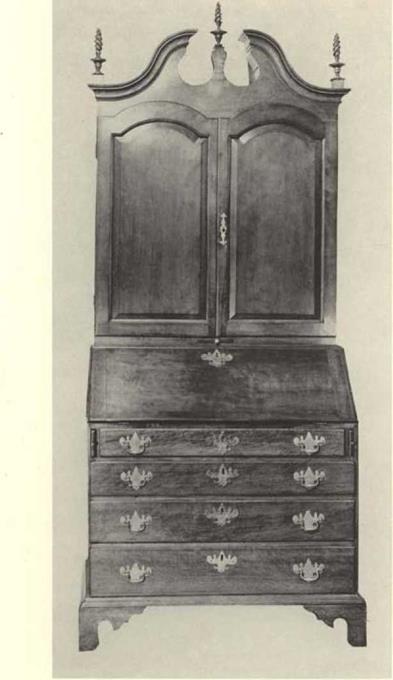
159, ГЭт, ц к and BooicitE. Made by Henjamin Frothingham (paper label), Cliarlestown, c. i7J J-i?!»- Cherry, (Present location unknown. Formerly in the collection оҐЕпіем Lo Nano: photo, Israel Sack, Inc., New York City.) See also tig. 160.
|
|
160. Inter] ob op Desk and Bookcase. Mjtlc by Benjamin Frcuhingham, (Present location unknown. Formerly in the collection of Ernest Lo Nano: photo. Israel Sark. Inc., New York City.) See also fig. 159.
|
|
161. Dusk ash lino к cast. Мл tic by JJctijamin Frotliingham [paper libel), Chirles – [own, c. 1753-1790. Mihoj>any atid while pine. (Prosit location unknown. Formerly in the collection of William T. Earls: photo, Antitjurs.)
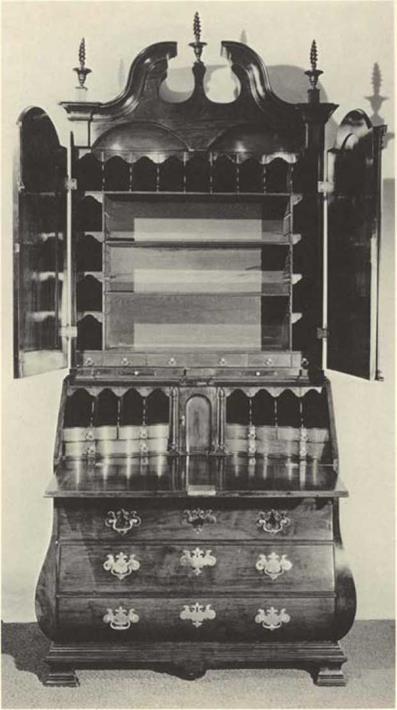
|
inscription: >lDo P Sprage Hcnj. Frodiingham.’ On two small interior dusk drawers on the bottom is "Ben), Froth Ingham,’’ and on die side of one document drawer is Oo S piage 175JThe placement of the inscription on (he big drawer is certainly appropriate only to those involved in the construction of the piece, and implies, since Spragc’s initials appear, that he was either a partner or workman in its construction. If the date is correct, it is die only dated example of Frothingham’s work, and is very’ early in his career. One might surmise that young Benjamin had gone into partnership before his father’s shop burned in 1760, and that he may have already moved from Boston to Charlestown since lie is recorded there in 1754. Another possibility might be that Frotbingbam and Spragc were apprentices nearing the end of their training with the elder Benjamin Frothingham. The construction of the secretary could then have represented die culmination of their apprenticeships and have shown to others their mastery of the craft of eabi net making. A final possibility is that the signature is not that oi the younger Frothingham, but that of his father. At the moment, however, since tio other work attributable to the father is know n, it is difficult to subtract this dated and fascinating piece from the work of the man who signed other pieces in a similar fashion. The discovery of facts relating to D, Sprage might settle the matter.11
Frothingham employed the ogee bracket foot on occasion, as seen On three re verse serpen tine mahogany desks. On the first, formerly in the collection of Mrs. Sidney Harwood (fig. irt}),1′ the foot has a bracket with a simple spur profile. The projecting sections of tile reverse serpentine terminate with round blocking in the upper drawer and with a depressed arch in the central area. Such a treatment occurs on a desk by Joseph Hosmer of Concord13 and on a number of pieces
11, Two Spragues ЛГС known to lu VC worked in The cabinet business ill Boston it Liter dates, nueof whom. Halite Sjir. igue, is recorded и working after rhe Revolution, See Mibfl M. Swin, "Boston і Carvers ami; Joiners. Part 11, Post-RcVolution – ary," ,jLm trines. 1Ш (April, 15148), ifij.
li. This desk wis mid in the Philip Fbydcrnun sale of January 2-4, 19JO. Set ‘Піс Collection of the Lille Philip Flaydninan (New Yuris, lpjo), L[lt 4’8.
Ethel Hall lljcrlste. The Слкімсіїміт of America (Garden City, New Yt>fls, 19 J7). pbte Kvitt, no. i.
from the Northampton area,1,1 as well as on a chest-on-ehcst with Boston details in the Henry Ford Museum,15 The interior of the desk has a projecting shelf with three drawers, above whieh is a pair of drawers below four ogcc-hcadcd pigeonholes on each side of the central section* The centra! door is treated with a reverse-blocked panel with a carved fan, and the two document drawers have plain pilasters with urn fmiaIs. The mahogany was chosen for its figure.
Remarkably similar to the Harwood desk is a second example, now in a private collection (figs. 164 and i6j). With the exception of a slight variation in the brasses and the addition of a shaped drop to the center of the skirt, this desk repeats virtually line for line the exterior shape and interior details of the Harwood desk, in addition, the blond mahogany of both desks compares quite closely in wood color and surface grain, suggesting that perhaps a single piece of mahogany was used for the drawer fronts of both pieces. According to the present owner, the second desk was purchased by her father in the Boston area about іуоі. Like the Harwood desk, it bears a Hurd label in the small reverse blocked central drawer of the interior*
A third labelled desk with ogee bracket Icet is in the collection of the Currier Gallery of Art (figs, iftf and 167)* The shape of the brackets and brasses is reminiscent of those on the two previous desks. However, the desk front has a less pronounced bow with only a bint of blocking on the upper drawer. The desk interior also differs, containing a double tier of drawers above a row of pigeonholes. A column of three central drawers is decorated with siring inlay and, on the upper drawer, with an inlaid fan. The use of inlay, a characteristic of Federal period work, suggests a date of manufacture of 1790 to 1 {too. A Hurd paper label appears in the middle drawer of the central section* According to David Brooke, Director of the Currier Gall cry, the desk descended in the Nichols family of Wiscasset, Maine, before coming to the Gallery in 1967*
14. Wilber Nutting, Fumifurr Treasury (191Ё; rpt. New York. 1934), fige 7ll,
lj. Hrlcn Cuni;tdcl(, Ллггттгли Funtihirr [New York, ISMS;), fig. S04. їй. Tltr interior и ihnwn by Spalding, "FratJiinghjm,,> p, JJ7, fig. 3.
 |
A metre elaborate desk is at Historic Deerfield (figs. 78, 79, 1 <58, and 169). it is of rich mahogany with square blocking and short cabriole legs carved with baity claws. Tile desk interior duplicates that of the Lo Nano secretary. The feet are the most extraordinary features. Ail four feet arc carved with four great talons grasping a
round bat!, and the fleshy parts of the foot arc rendered so as to represent the effect of pin feathers. The brackets are blocked on die front and have the spur profile. The foot is smaller and more compact than the examples of hairy claw feet by George bright and other cabinetmakers of die Boston area.17 Two block from chests of drawers with plain bracket feet bear the
17. Richard H, Randall, Jr., Amtritan Fumlturt in the Микит of Pint Ani, Boston (Uoicoti, ictfs), fig. 64d.
|
164, Dssk – Made by Jlcnjaiiiiti Fro 1 limp!)inіь {paper label), Charlestown, c. 17^-1750. Mahogany and white pine; h. 41% inches, w, 413/j inches, n. 2iT.-K inches. (Private collection.) See also fig. ldj. |
165. Interior of Desk. Made by benjamin Froth mgh. nn, (Private collection.) Set also fig. 164.
|
|
166- Disk. Made by Benjamin Frothingh. nn {paper label/, Charlcttown, c. і7Ло-іЯ*0. Mahogany and white pint; H. 11 inches, W. 44 inches., d, 24 inches. (The Currier Gallery of Art.) See also lig – ІЙ7-
|
167, IntfkiohofDi:SX. Maieby BenjaminFrothpighim, (11k Comer Cillery оґЛгг.) See also tig. 166, |
label of Frorhingham. The first example (fig, 170) has square blocking similar to the Deerfield desk; the bracket has the same spur detail seen on other examples. The top of the piece, which 1 have never examined, has almost no overhang, a feature unusual in Boston practice, and suggests that this might have been the base of a chcst – 011-cliest originally. The piece bears the Hurd paper label in the
drawer and was in the collection of Mrs, Ernest L, Ructcr in 1952.IB
The second chest, documented by a fragmentary Hurd label in the upper drawer, has rounded blocking and a molded top which follows the contours of the front. It closely resembles a chest signed m chalk by Walter Frothingham. an unidentified member of the Froth – mg ham family. Mr. and Mrs. Stephens Croom of Mobile, Alabama, owned the chest in 1964.19
A chcst-on-chcst, now in a private collection, is one of the most masterful of Frothingham’s works (fig. 1). It again carries the Hurd paper label. The lower ease is square blocked, and its lines carry down into a blocked ogee bracket foot of a type rarely met outside of Rhode Island. The upper case is flanked by fluted pilasters with pu Ivina ted caps. The carved fan in the central upper drawer is of the most elaborate type found in the Boston area. It is based on stylized acanthus leaves; the main area of the fan is a leaf with undulating edges, Its surface is decorated with punched ovals and at the lower center is a smaller leaf in high relict and a row of scrolling leaves across the base. The richness of carving is continued into the open bonnet with its two floral rosettes, and die three corkscrew fuuals have pierced bases, giving them a weightlessness and a richness of light and shade. The lower ease is supplied with side brasses, matching the large pine-tree type of the drawers.^0
Having worked in die styles of die middle and third quarter of the гетиту, Frothingham turned his attention to those of the last years
iB. Swan, “Major benjamin Froshiiighain," p. J9J.
19. For illustrations of (ho chtsi aid label, sec Margaret Кок Lngaic, “History in Towns: Mobile, Alabama," .НлАфігі, txxxv (March. 1964}, jop. For illustrations of the Waller Fretilin i’ll. im chest. s« Comstock. “Fruihiughani and (he Question of Attributions." p. sos, figs. 13, 14.
10. Antiques, Lxn (November, ipjaj, frontispiece. This typo of richly carved fan exists in a number oflkiston examples inducting the Hancock dressing table, now in the John Hancock Insurance Company Collection [Albert Sack, Fiat Points ofFtimi – Інк: Early American [New York, p. 19H, bottom) 1 л pad-fooi hi&h chest now ai
(he Metropolitan Museum of An (Luke Vincent Lockwood, CuJbmaJ Pnmlaot m America, 3rd ed.. 1 vois. |New York, 19аА|, 1. 97, fig. 94); and a block front chcst-on – cheii (Lockwood, Cvlixiiel Furniture, i. 360, fig. xxvu); all perhaps by ihe same carver.
of the century. He is known to have made three pieces of labelled furniture in die new neoclassical manner of Hcpplcwhice. One is a characteristic New England chair with ал um-dccoratcd bach, of a type made in Newport, Providence, Salem, and Boston (fig, 171),
|
163. Desk. Made by Benjamin Frnthingham, (Historic Deerfield, Inr., Deerfield, Massachusetts.) See also figs. 7*, 7У, and 169- |
The Boston-area chairs arc usually unearned on the lower semicircle of the back splat, as is the case with this chair. The legs are molded, and across the underside of the rear scat rail is lettered "Mr Bcnjan. Froth high am f Charlestown" in ink, [f it is not a mark of ownership, it is likely that this was the inscription of an upholsterer who wished to know to whom the chair should be returned. While it is one of only two surviving chairs associated with Frothingham, his shop inventory listed “6 cheats" indicating that he had always made a certain number, The chair is owned by the Toms Foundation of Knoxville, Tennessee.21
Another chair, which descended in the Frothingham family, is in the Museum of Fine Arts, Boston, and carries die legend that it was made in the shop of Benjamin F’rothmgham, As it is a Windsor
ii, Swan, “Mijur iJotjnniu Frothingham,” p. jpa showing inscription.
|
169. DEtAll or Foot or Desx. Made by Benjamin Frothingham. (Historic jDterfield, hie., Deerfield, Massachusetts.) See also ftgs. 79, and ійМ. |
|
IT’D, Cjiist of Diuwirs. Made by Benjamin Froihingham (paper label], Charlestown, c. 1755-17510. Mahogany. (Present location unknown. Formerly in the collection of Mrs, Frncst L, Ruder: photo, Antitpies,) |
chair, with bow back and continuous arms, it seems hardly likely to have been die product of Frorhinghani’s shop. Windsor chair making was a specialty in the cabinet trade; it is far more likely that Frotli – ingham purchased the chair for bis daughter. It is interesting in being a documented example of furniture which did belong to a cabinetmaker’s family,22
The second neoclassical example, which has been in unknown hands since tile Philip Flayderman sale of 1930 where it was lot 417, is a serpentine-front sideboard (fig, 172). The unfortunate brasses of
гг, Randall, Лтггіевп Furniture, p, the photograph distract one from the quality of this unusual New England board with three central drawers. The doors and drawers arc well veneered and banded, with the door keyholes carried out as diamond inlays. The stiles and tapering legs have long round-headed panels of stringing, those of the legs having a single bellflower at the top of each panel. The cuffs are banded, and the top is finished with a double-beaded edge. It was described in the Fliydemian catalogue as being of ’Tine figured mahogany, banded with cross-cut wood of beautiful col or." [74]
The third example is a typical D-shaped card table in a characteristic Massachusetts manner. It has good stringing in the legs with a small panel of lighter wood at the top of the leg, and a checkered band across the bottom of the skirt. It is built of good, well-figured mahogany і but has few characteristics that indicate its origins in Froth ingham’s shop, other than a finely preserved label on the underside. It is in the collection of Joseph Kindig ttt.
While I do not wish to discuss the attributions to Frotbingham. of which many have been made, 1 would like to point our that certain pieces such as the secretary in the William RockhilE Nelson Gallery with its bracket feet, similar bonnet, and identical desk interior show such affinity to Frotbingham that it is hard to interpret them as merely regional similarities.[75] The fall-front square blocked desk at Colonial Williamsburg again shares the general features, with minor variations in die pen drawers of the desk interior, and is one of only a few Boston-area casepicccs having blocked ogee bracket feet with scroll returns. This is related to the treatment of the Frotbingham chcst-on-chcsl and bears ail obvious indirect relation to Newport sources,[76]
Three surviving bills from Frotbingham indicate the variety of work performed in his shop. On June tz, 1788, he billed Colonel
|
|
І7Ї, Side Chair, Made or owned by Benjamin flrothtngham (inscription in ink}, Charlestown, c. 1790-1809. Mdiogiiiy, ketch, and maple; u. 33 inches, w. 22 inches, d„ 18 inches. (Tin? Toms Ьчіпіі. и і on. Crrit’he. jJ-J action House, Knoxville, Tennessee.)
Ervin for two held bedsteads, and, on April 17,1789, William Steams for a coffin яги) furniture,26 On January 16, 1797, he charged Genera! Henry Knox of Thomaston, Maine. .£57:8:0 for the following:
|
To г large mohegany Card Tables |
£ 6:iz:q |
|
|
To 2 Djittjo Do Pembrook Do To 1 large mohogany bedsted foot & |
6:12:0 |
|
|
Side boards |
12:10:0 |
|
|
Tor Do without foot Board |
11: 0:0 |
|
|
To large mohogany ward Robe |
16:10:0 |
|
|
To a Cornish & Painting |
4: 4^7 |
|
|
The contents of his shop, destroyed by fire |
in 1775, shed further |
|
|
light on |
the general si2c of Frcthmgham’s production where the fed- |
|
|
lowing |
items were listed: |
|
|
1 Mahogany Case draws [£] 7: 0:0 |
||
|
i Buxdw tabel |
4: 0:0 |
|
|
3 Walnut Case draws |
17:10:0 |
|
|
) 2 labels of suites |
20: 0:0 |
|
|
6 chcars |
0:14:0 |
The wood inventory ol the same year includes cherry and **yal- lowsander wood," probably American gum wood which frothing – ham’s inventory clerk put down as sandalwood because ofits similar yellow color. This seems more likely than the interpretation that it was "palisander” or rosewood, which is purplish in hue. The list is as follows:
|
a Quantity of Mahogany boards & planks |
Ші4: 0.0 |
|
Walnut hoards |
14: 0:0 |
|
Chcrrytrcc boards |
l: 0:0 |
|
Mapolc planks, pmeboards. planks |
8: 0:0 |
|
a Quantity of Yallowsander wood |
3:10:0** |
|
26. Swan, "Mjjof Driijiuiirt Ffothiiigllitl)," p. 393. 17. (iCricril Henry Kmii! u tk’njimin Fmthingliirn, Cbiflotoivn, Jimury 16, 1797, Henry Knox 1’ipcii (Miinr! hi! i.uіl j] Snrirly). Courtesy of Eirle Siheitlo worth, j#. Quoted in Swat), "Mijdr Benjamin Froihinjtham," p. Jyj- |
While WC certainly have today only a fragment of the production of Benjamin Frothmgham from his career of more than fifty years, the pieces that survive with his label show a man working in the best traditions through three phases of style. He was therefore both skilled and aware of his customers’ needs. His use of unusually beautiful or colored woods—plum pudding mahogany, cherry, and "yallow – sander”—indicate cither that there may have been sonic differences in taste between Boston and Charlestown or that the cabinetmaker himself enjoyed unusual woods. His choice of brasses, also, judging from the evidence of two sets of pierced ones, is something more than ordinary.
However, it is very difficult to attribute the richness of taste in details to the cabinetmaker of die eighteenth century. The taste was more often that of the customer. While we know a certain amount about Frothingham, wrc have, except for three bills, very little knowledge of his clientele. For them it appears that he produced mostly casepicces—desks, secretaries, and chests of drawers—though tables formed a good portion of his 1775 inventory and account for two of his surviving pieces. That he also made chairs is implied by the inventory and affirmed by the I Icpplcwhite shield-back example,
A number of details remain to be discovered. Who was the I, Gold whose name appears on the brasses of the Davis-Winterthur examples, and who was the П. Sprage who signed the bombf secretary? To judge from the majority of his cabinetwork, it svould be interesting to know if he was a carver himself or if, more likely, he employed a carver to produce the elaborate fan of the privately owned chest-on-chest and the hairy paw feet of the Deerfield desk.
Certainly, Major Benjamin Frothinghnm was a man well known and honored in his own day. He was also financially successful. His claims of 177^ show that he owned a shop valued at ^26, a bam at £40, and a house of £220 value, In 1809 he died possessed of twenty – seven square rods of land and a building valued at $2500. He has left behind what many other Boston-area makers have denied us, a series of labelled examples ranging from the mid-eighteenth century to the early nineteenth century. While this tells much about Frothingham
|
|
172. Side воля d. Made by Ilchjjmiis Frorhinghah] [paper libel), Charlestown, e. 17901809. Mahogany and white pine; n. 38 inches, w. 59 inches, D* 25 inches. (Present Iocatioti unknown, Sold д[ the American Art Association auction of the «rate of Philip Flaydcrman, January 2-4, 1930, lot 417: photo, AmiijiffJ.)
as an individual, it tells an equal amount about his contemporaries in boston and vicinity, and what one may expect 10 have emerged from their shops. There has yet to be discovered a daybook of a Boston maker, where 011c can learn the day-to-day business of the Cabinetmaker as that of the silversmith is outlined by Paul Reverc’s accounts. However, the labelled furniture of frothing!!am comes closest to showing t! ie range and variety of the Boston cabinetmaker s work.
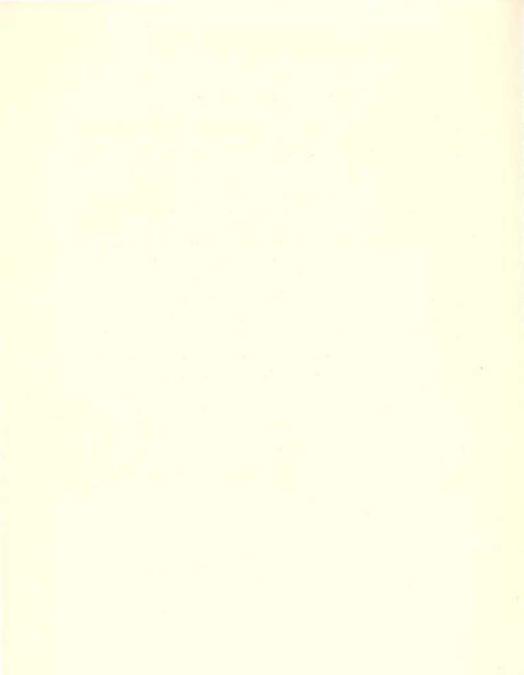
|
|
+0 GORDON SALTAR г*
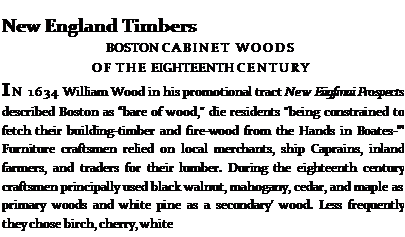
oak, red oak, and chestnut. The 1797 inventory of the estate of Samuel Fisk, one of Boston’s wealthiest cabinetmakers, included not only a “Pile of Bay Mahogany" valued at SJ2J.29 and "23 3 feet Jamaica Mahy“ valued at $42.30, but also;
ji feet black Walnut at fS]-—4 [per foot] |$] 2.-4
2 Logs of d[ittJo in the Shed 2,—-
720’/j feet of Mahy at the Mill in
Watertown at.44% pr foot 10447
292 feet Chcsiiut at 1.50 pr hund 4.38
194 feet Cherry tree boards at 2.50 pr hund 4.85
573 feet clear pine boards it 12.0 pr M [thousand] 6.87 1023 feet Maple joysts at 1.50 pr hundd 1 5.34
844 do boards at 1. pr hundred 8.44
2 birch planks 3.—
Ebony tc wood for Inlays 3.—’
1. Queued ill Nilhillicl It. Shim I elf A Topographical anJ Historical Description о/ BoMm, 3rd cd. (Button, 1891), pji. 40-41.
2. Suffolk Comity Registry ufPfubitr, Boitnn. Muudiiixtu, docket aoddS.
Black walnut, popular throughout most of the century, was imported largely from the southern and middle colonics. In 1774 while travelling through New Jersey, John Adams spotted a row of four large black walnut trees and commented, ‘‘It seems that these Trees arc plenty’ in these Southern Provinces—all the black Walnut Timber which is used by our Cabinet Makers in Boston is brought from the Southern Provinces."-‘
By the 1730s mahogany had become a fashionable wood in Boston. Shipped from the West Indies and Central America, die wood was sold by the piece at local vendues or marketed by merchants.[77] [78] According to the Boston physician William Douglass (c. 16911752), "Mahogany wood of the West-Indies” was excel lent for cabinet and joiners’ work, “much surpassing the red cedar of Carolina and Bermudas, which has a disagreeable perfume."[79] [80]
Despite Douglass’ comments, Boston cabinetmakers occasionally used red cedar in their furniture. Merchants imported some cedar from the South; however, much more came from the lowlands and swamp of eastern Massachusetts. Based on surviving evidence, the wood seems to have gained popularity’ between about 1720 and 1760. In the November 2Я – December j. 1728, issue of The Boston NewsLetter, the printer advertised “A Fine Red New Cedar Desk" for sale, After the disastrous fire of 17Й0, Thomas hoot, a local cabinetmaker, listed among his losses, "36 foot Cedar Logs" valued at
Boston craftsmen easily obtained native hardwoods such as cherry
or maple. Yeomen in surrounding towns often traded lumber with merchants or craftsmen for imported foodstuffs and doth. While documented Boston furniture of cherry is scarce, John Adams noted during a visit to the Braintree home of John Borland that "The Wood [cherry] is very good for the Cabinet-Макет.. , . It is a tree of much Beauty,”[81] Maple, on the other hand, is seen in many pieces of Boston furniture. Japanned high chests, for example, are almost always constructed of maple. The close-grained wood provided an excellent base for the many layers of white lead, vermilion, lampblack, and gold leaf used by the japaliner.
White pine, ‘the tallest and most stately tree of our forests,”0 was common throughout New England, Beginning early in the seventeenth century. merchants and millwrights established sawmills in coastal settlements and shipped cargoes of sawn pine boards and planks to Boston,[82] [83] White pine was, according to William Douglass, “much used in framing of houses and in joiners svork, scarce any of it to be found south of New-England, In joiners work, it is of a good grain, soft, and easily wrought."[84]
Gordon Saltar has prepared the following list of New England woods available to furniture craftsmen in the eighteenth century. 1 le has included those properties which might have been of concern to cabinetmakers. The log diameters represent the average. The geographical ranges represent coastal regions only. An annotated bibliography on the identification of woods is presented at the end of the article.
BkOCK Jobs



